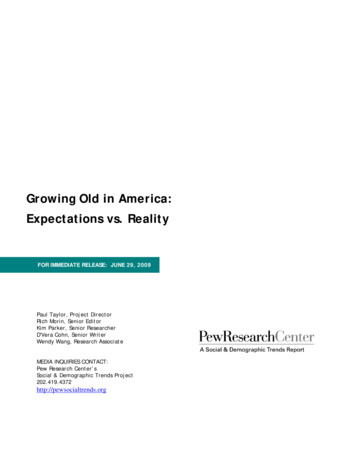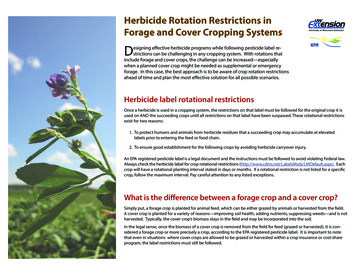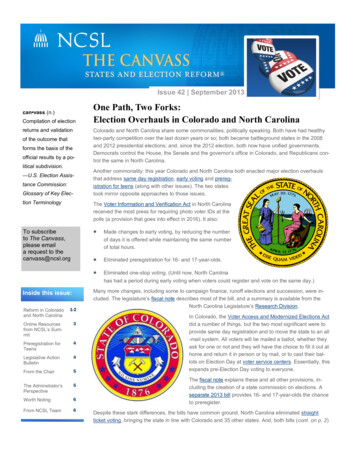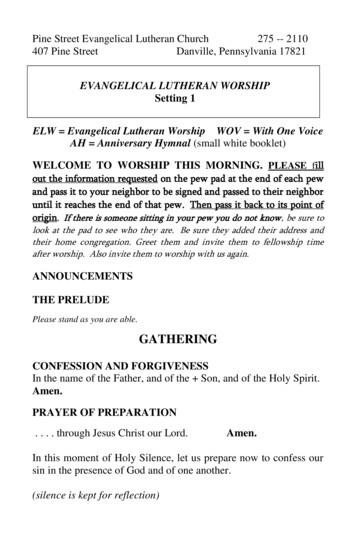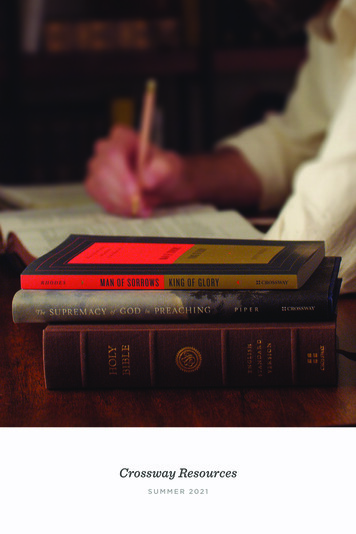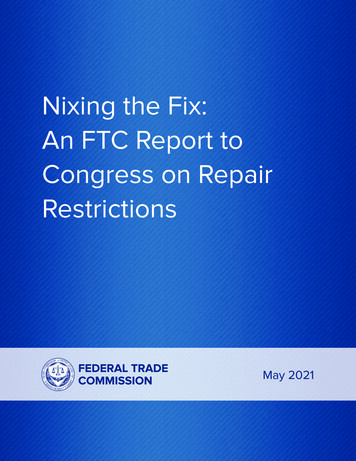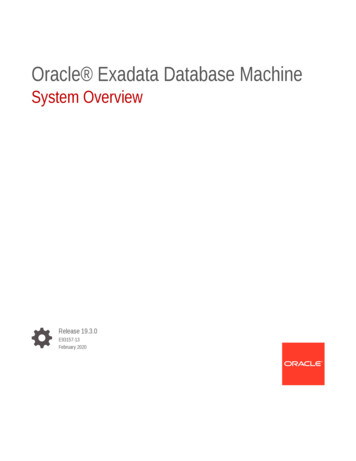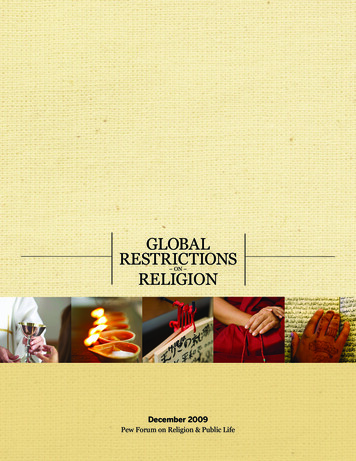
Transcription
GLOBAL RESTRICTIONSRELIGION – ON – December 2009Pew Forum on Religion & Public Life
About the Pew Forum on Religion & Public LifeThis report was produced by the Pew Research Center’s Forum on Religion & Public Life. The PewForum delivers timely, impartial information on issues at the intersection of religion and publicaffairs. The Pew Forum is a nonpartisan, nonadvocacy organization and does not take positionson policy debates. Based in Washington, D.C., the Pew Forum is a project of the Pew ResearchCenter, which is funded by The Pew Charitable Trusts.This report is a collaborative effort based on the input and analysis of the following individuals:Pew Forum on Religion & Public LifeLuis Lugo, DirectorResearchAlan Cooperman, Associate Director, ResearchBrian J. Grim, Senior ResearcherSahar Chaudhry, Research AnalystJacqueline E. Wenger, Research AssociateMaura Bardos, Michelle Burns, James P.Emanuel, Jr., Lyn-Ni Lee, Hilary Ramp, BrettRector, Joshua Turner, CodersCommunications and Web PublishingErin O’Connell, Associate Director, CommunicationsOliver Read, Web ManagerRobert Mills, Communications AssociateLiga Plaveniece, Program CoordinatorPew Research CenterAndrew Kohut, PresidentPaul Taylor, Executive Vice PresidentScott Keeter, Director of Survey ResearchMichael Keegan, Graphics DirectorAlicia Parlapiano, Infographic DesignerEditorialSandra Stencel, Associate Director, EditorialDiana Yoo, Graphic DesignerTracy Miller, EditorHilary Ramp, Assistant EditorVisit http://pewforum.org/docs/?DocID 491 for the online presentation of Global Restrictions onReligion.Pew Forum on Religion & Public Life1615 L St., NW, Suite 700Washington, D.C. 20036-5610Phone (202) 419-4550Fax (202) 419-4559www.pewforum.org 2009 Pew Research CenterPhotos: Pastor giving Communion cup to woman, SW Productions/Brand X/Corbis; Traditional Hindu Ghee Diya candles,Ken Seet/Corbis; Shinto prayer boards hanging on hook, moodboard/Corbis; Buddhist monk holding prayer beads,Parallax Photography/Corbis; Young Kashmiri woman reading the Koran, Yannis Behrakis/Reuters/Corbis
Global Restrictionson ReligionTable of ContentsExecutive Summary . 1Limitations of the Study . 4Government Restrictions Index (GRI) . 6Table . . 12Social Hostilities Index (SHI) . 17Table . . 22Comparing Government Restrictions and Social Hostilities . 27Methodology . 31Index Scores by Region . 49Summary of Results . . 53
Pew Forum on Religion & Public Life / Global Restrictions on ReligionExecutive SummaryFor more than half a century, the United Nations and numerous international organizations haveaffirmed the principle of religious freedom.1 For just as many decades, journalists and humanrights groups have reported on persecution of minority faiths, outbreaks of sectarian violence andother pressures on religious individuals and communities in many countries. But until now, therehas been no quantitative study that reviews an extensive number of sources to measure howgovernments and private actors infringe on religious beliefs and practices around the world.Global Restrictions on Religion, a newstudy by the Pew Research Center’s Forumon Religion & Public Life, finds that 64nations – about one-third of the countriesin the world – have high or very highrestrictions on religion. But because someof the most restrictive countries are verypopulous, nearly 70 percent of the world’s6.8 billion people live in countries with highrestrictions on religion, the brunt of whichoften falls on religious minorities.Global Restrictions on ReligionA minority of countries have high restrictions on religion,but these countries contain most of the world’s population.Percentageof CountriesPercentage ofGlobal PopulationLowHigh orVery High32%15%Low48%High orVery HighModerate16%Some restrictions result from government70%actions, policies and laws. Others resultModerate20%from hostile acts by private individuals,organizations and social groups.The highestoverall levels of restrictions are found incountries such as Saudi Arabia, PakistanNote: Totals may not add to 100% due to rounding.and Iran, where both the government andPew Forum on Religion & Public Lifesociety at large impose numerous limitsGlobal Restrictions on Religion, December 2009on religious beliefs and practices. Butgovernment policies and social hostilitiesdo not always move in tandem. Vietnamand China, for instance, have high government restrictions on religion but are in the moderate orlow range when it comes to social hostilities. Nigeria and Bangladesh follow the opposite pattern:high in social hostilities but moderate in terms of government actions.According to Article 18 of the 1948 Universal Declaration of Human Rights, one of the foundational documents of theU.N., “Everyone has the right to freedom of thought, conscience and religion; this right includes freedom to change hisreligion or belief, and freedom, either alone or in community with others and in public or private, to manifest his religionor belief in teaching, practice, worship and observance.”1Executive Summarywww.pewforum.org1
Pew Forum on Religion & Public Life / Global Restrictions on ReligionAmong all regions, the Middle East-North Africa has the highest government and social restrictionson religion, while the Americas are the least restrictive region on both measures. Among theworld’s 25 most populous countries, Iran, Egypt, Indonesia, Pakistan and India stand out as havingthe most restrictions when both measures are taken into account, while Brazil, Japan, the UnitedStates, Italy, South Africa and the United Kingdom have the least.Executive Summarywww.pewforum.org2
Pew Forum on Religion & Public Life / Global Restrictions on ReligionReligious Restrictions in the 25 Most Populous CountriesThis chart shows how the world’s 25 most populous countries score in terms of both governmentrestrictions on religion and social hostilities involving religion. Countries in the upper right havethe most restrictions and hostilities. Countries in the lower left have the least.VERY pinesiMODERATECongoSouth nt RestrictionsNote: The Pew Forum categorized thelevels of government restrictions andsocial hostilities involving religion bypercentiles. Countries with scores in thetop 5% on each index were categorizedas “very high.” The next highest 15% ofscores were categorized as “high,” andthe following 20% were categorized as“moderate.” The bottom 60% of scoreswere categorized as “low.”Circles are sized proportionallyto each country’s ionPew Forum on Religion & Public Life Global Restrictions on Religion, December 2009Colors are based on eachcountry’s position on the chart.MOREHOSTILITIESSocial HostilitiesBangladeshdMORERESTRICTIONS
Pew Forum on Religion & Public Life / Global Restrictions on ReligionThe Pew Forum’s study examines the incidence of many specific types of government and socialrestrictions on religion around the world. In 75 countries (38%), for example, national or localgovernments limit efforts by religious groups or individuals to persuade others to join their faith.In 178 countries (90%), religious groups must register with the government for various purposes,and in 117 (59%) the registration requirements resulted in major problems for, or outrightdiscrimination against, certain faiths.Public tensions between religious groups were reported in the vast majority (87%) of countries inthe period studied (mid-2006 through mid-2008). In 126 countries (64%), these hostilities involvedphysical violence. In 49 countries (25%), private individuals or groups used force or the threat offorce to compel adherence to religious norms. Religion-related terrorism caused casualties in 17countries, nearly one-in-ten (9%) worldwide.These are some of the key findings of Global Restrictions on Religion.The study covers 198 countriesand self-administering territories, representing more than 99.5% of the world’s population. Inpreparing this study, the Pew Forum devised a battery of measures, phrased as questions, togauge the levels of government and social restrictions on religion in each country. To answerthese questions, Pew Forum researchers combed through 16 widely cited, publicly availablesources of information, including reports by the U.S. State Department, the U.S. Commission onInternational Religious Freedom, the U.N. Special Rapporteur on Freedom of Religion or Belief, theCouncil of the European Union, the United Kingdom’s Foreign & Commonwealth Office, HumanRights Watch, the International Crisis Group, the Hudson Institute and Amnesty International. (Forthe complete list of sources, see page 34 of the Methodology.)The researchers involved in this process recorded only factual reports about government actions,policies and laws, as well as specific incidents of religious violence or intolerance over the maintwo-year period covered by this study, from mid-2006 to mid-2008; they did not rely on thecommentaries or opinions of the sources. (For a more detailed explanation of the coding and dataverification procedures, see page 35 of the Methodology. For the wording of the questions, seethe Summary of Results on page 53.) The goal was to devise quantifiable, objective measuresthat could be combined into two comprehensive indexes, the Government Restrictions Index andthe Social Hostilities Index. Using the current, two-year average as a baseline, future editions ofthe indexes will be able to chart changes and trends over time.Global Restrictions on Religion is part of a larger effort – the Global Religious Futures Project,jointly funded by The Pew Charitable Trusts and the John Templeton Foundation – that aims toincrease knowledge and understanding of religion around the world.Limitations of the StudyIt is important to keep a few caveats in mind when reading this report. First, because freedom– defined as “the absence of hindrance, restraint, confinement or repression” – is difficult if notExecutive Summarywww.pewforum.org4
Pew Forum on Religion & Public Life / Global Restrictions on Religionimpossible to measure, the Pew Forum’s study instead measures the presence of restrictionsof various kinds. The study tallies publicly reported incidents of religious violence, intolerance,intimidation and discrimination by governments and private actors. That is, it focuses on theproblems in each country. It does not capture the other side of the coin: the amount of religiousdynamism, diversity and expression in each country. The indexes of government restrictions andsocial hostilities are intended to measure obstacles to the practice of religion. But they are onlypart of a bigger picture.Second, this study does not attach normative judgments to restrictions on religion. Every countrystudied has some restrictions on religion, and there may be strong public support in particularcountries for laws aimed, for example, at curbing “cult” activity (as in France), preserving anestablished church (as in the United Kingdom) or keeping tax-exempt religious organizations fromendorsing candidates for elected office (as in the United States). The study does not attempt todetermine whether particular restrictions are justified or unjustified. Nor does it attempt to analyzethe many factors – historical, demographic, cultural, religious, economic and political – that mightexplain why restrictions have arisen. It seeks simply to measure the restrictions that exist in aquantifiable, transparent and reproducible way, based on reports from numerous governmentaland nongovernmental organizations.Finally, although it is very likely that more restrictions exist than are reported by the 16 primarysources, taken together the sources are sufficiently comprehensive to provide a good estimateof the levels of restrictions in almost all countries. The one major exception is North Korea. Thesources clearly indicate that North Korea’s government is among the most repressive in the worldwith respect to religion as well as other civil and political liberties. (The U.S. State Department’s2008 Report on International Religious Freedom, for example, says that “Genuine freedom ofreligion does not exist” in North Korea.) But because North Korean society is effectively closed tooutsiders and independent observers lack regular access to the country, the sources are unableto provide the kind of specific, timely information that the Pew Forum categorized and counted(“coded,” in social science parlance) for this quantitative study. Therefore, the report does notinclude scores for North Korea.Executive Summarywww.pewforum.org5
Pew Forum on Religion & Public Life / Global Restrictions on ReligionGovernment Restrictions Index (GRI)The Government Restrictions Index is based on 20 questions used by the Pew Forum to assesswhether governments – including at the local or provincial level – restrict religious practices orbeliefs. The questions are intended to gauge the extent to which governments try to controlreligious groups or individuals, prohibit conversions from one faith to another, limit preaching andproselytizing, or otherwise hinder religious affiliation by means such as registration requirementsand fines. The questions seek to capture both relatively straightforward efforts to restrict religion– for example, through a nation’s constitution and laws – as well as efforts that are more indirect,such as favoring certain religions by means of preferential funding.Because no single type of restriction is a reliable indicator of the overall level of restrictions in acountry, the study covers a wide array of possible restrictions. But because some governmentactions have less impact than others on people’s lives, several of the questions allow for gradationsor contain multiple sub-questions. This effectively gives some restrictions (such as favoritism infunding religious buildings and schools) less weight in the index than others (such as physicalviolence toward religious minorities). The questions are shown in the Summary of Results onpage 53; detail on how all 198 countries and territories scored on each question is available online,in the Results by Country.The mathematical presentation of these scores needs to be kept in context. If the GovernmentRestrictions Index were based on 15 well-chosen questions instead of 20, for example, somecountries’ scores would change, and even the order in which the countries appear on the indexmight shift in small ways. The Pew Forum has deliberately chosen not to attach numerical rankingsfrom No. 1 to No. 198 both because there are many tie scores and because the differencesbetween the scores of countries that are close to each other on the index may not be important.This is particularly the case at the low end of the scale, where most countries are clustered.By contrast, the numerical differences at the top end of the scale, among the relatively smallnumber of countries with very high restrictions, are more meaningful. (See page 38 of theMethodology.)The most meaningful comparisons, however, are between broad ranges that reflect observabledifferences in real-world behavior. Accordingly, the Government Restrictions Index is divided intofour ranges: very high (the top 5% of scores), high (the next highest 15% of scores), moderate(the next 20% of scores) and low (the bottom 60% of scores).Countries with very high government restrictions have intensive restrictions on many or all ofthe 20 measures. In Brunei, for example, a 2005 law requires all religious groups other than theofficial Shafii sect of Islam to register with the government and to provide the names of theirmembers. In addition, authorities in Brunei enforce religious norms, including arresting peoplefor being in too close proximity to the opposite sex. Although conversion is technically legal,Government Restrictions Indexwww.pewforum.org6
Pew Forum on Religion & Public Life / Global Restrictions on Religionpermission is required from Brunei’s Ministry of Religious Affairs before converting from Islam toany other faith.Countries with high government restrictions have intensive restrictions on several of the20 measures, or more moderate restrictions on many of them. For example, in Greece, thegovernment allows only Orthodox Christian, Jewish and Muslim organizations to own, bequeathand inherit property as well as to have an official legal identity as a religion. Other religious groups,including other Christians, thus operate at a disadvantage.Countries with moderate government restrictions have intensive restrictions on a few measures,or more moderate restrictions on several of them. Cambodia, for example, has a Ministry of Cultsand Religions that has repeatedly prohibited Christians from going door-to-door to talk about theirfaith or pass out religious literature, and the government gives preferential treatment to Buddhism,the state religion. In France, proponents of a 2004 law banning the wearing of religious symbolsin schools say it protects Muslim girls from being forced to wear a headscarf, but the law alsorestricts those who want to wear headscarves – or any other “conspicuous” religious symbol,including large Christian crosses and Sikh turbans – as an expression of their faith.Countries with low government restrictions generally have moderate restrictions on few or noneof the measures. In the United Kingdom, for instance, the head of state is also the head of theChurch of England, yet the government does not always favor the officially established church.For example, during the period covered by this study, a British court allowed employers to requireChristians to hide their religious symbols in the workplace while not requiring the same of otherfaiths.Government Restrictions Indexwww.pewforum.org7
Pew Forum on Religion & Public Life / Global Restrictions on ReligionPatterns in Government RestrictionsAn analysis of the data shows thatgovernment restrictions on religionare high or very high in 43 countries,about one-in-five. But because manyof these are populous countries(including China, India and Pakistan),more than half (57%) of the world’spopulation lives with high or very highgovernment restrictions on religion.A much larger number of countries –119 – have low levels of governmentrestrictions. But many fewer people,about one-in-four (26%), live in thesecountries.Government Restrictions on ReligionThe percentage of the world’s countries with highor very high government restrictions is about 20% . . .60%Low Levels20%Moderate20%High or Very High. . . but because many of these are populous countries,the percentage of the world’s population living withhigh or very high government restrictions is 57%.As the results clearly show, it is not26%16%57%sufficient simply to look at formalconstitutional protections whengauging the level of governmentrestrictions on religion. Most (76%)of the 198 countries and territoriesincluded in the study call for freedomNote: Totals may not add to 100% due to rounding.of religion in their constitutions orPew Forum on Religion & Public Lifebasic laws, and an additional 20%Global Restrictions on Religion, December 2009protect some religious practices.But the study found that only 53governments (27%) fully respected the religious rights written into their laws. Afghanistan’sConstitution, for instance, appears to protect its citizens’ right to choose and practice a religionother than Islam, stating that “followers of other religions are free to perform their religious riteswithin the limits of the provisions of law.” The Constitution qualifies that measure of protection,however, by stipulating that “no law can be contrary to the sacred religion of Islam” and instructingjudges to rule according to Shariah law if no specific Afghan law applies to a case. In 2006, forexample, an Afghan citizen, Abdul Rahman, was tried and sentenced to death in accordancewith several judges’ interpretation of Shariah law for converting from Islam to another religion.Rahman eventually was granted asylum in Italy. (Overall, Afghanistan ranks high in governmentrestrictions.)It is also important to look carefully at government policies that on the surface appear to beneutral but in practice serve to restrict religion. For example, 178 countries (90%) requirereligious groups to register with the government for one purpose or another, such as to obtainGovernment Restrictions Indexwww.pewforum.org8
Pew Forum on Religion & Public Life / Global Restrictions on Religiontax-exempt status or import privileges.Further analysis shows, however, thatin almost three-in-five countries (59%),these registration requirements resultin major problems for (19%) or outrightdiscrimination against (40%) certainreligious groups. Singapore’s SocietiesAct, for example, requires all religiousgroups to register with the government.In 1972, the government de-registeredthe Jehovah’s Witnesses, and in 1982it de-registered the Unification Church,effectively criminalizing the practice ofthose religions. (Singapore ranks high ingovernment restrictions.)Registration RequirementsDoes any level of government ask religiousgroups to register for any reason, includingto be eligible for benefits such as tax exemption?10% No31% Yes, but in a nondiscriminatory way19% Yes, and the processadversely affects the abilityof some religious groupsto operateSimilarly, the vast majority of governments(86%) provide funding or other resourcesto religious groups. But in 151 countries40% Yes, and the process(76%),governmentsprovidethisclearly discriminates againstassistance in ways that are either clearlysome religious groupsimbalanced or that favor only one religiousgroup. For example, in Canada – whichranks low in government restrictions – sixof the 10 provinces provide some levelGRI.Q.18of funding for religious schools, but inPew Forum on Religion & Public LifeGlobal Restrictions on Religion, December 2009Ontario, only Catholic education is funded.It is important to note that governmentsupport for religious groups is considered a restriction in this study only if it involves preferentialtreatment of some group(s) and discrimination against others. (See Summary of Results, GRIQuestion No. 20.3, on page 61.)Government Restrictions Indexwww.pewforum.org9
Pew Forum on Religion & Public Life / Global Restrictions on ReligionOther government restrictions are much more obvious. Nearly half of all countries either restrictthe activities of foreign missionaries (41%) or prohibit them altogether (6%). In addition, nationalor local governments in 75 countries (38%) limit efforts by some or all religious groups topersuade people to join their faith. In Indonesia, for example, the government’s Guidelines forthe Propagation of Religion bar most proselytizing, and Article 156 of the Criminal Code makesspreading heresy and blasphemy punishable by up to five years in prison. (Indonesia ranks highin government restrictions.)During the main period covered by this study, from mid-2006 to mid-2008, the governments in 137countries (69%) harassed or attempted to intimidate certain religious groups, and in 91 countries(46%) there were reported cases of the use of physical force against religious individuals orgroups by governments or government employees. Police in Eritrea, for example, detained someadherents of unregistered churches and compelled them to renounce their faith and join theOrthodox Christian Church in order to win release. And in Burma (Myanmar), the governmentactively enticed Muslims and Christians to convert to Buddhism. (Both Eritrea and Burma are inthe very high category for government restrictions.)Among the other countries with very highlevels of government restrictions on religionare several that are frequently cited for thelimits they impose on minority faiths. Theseinclude Saudi Arabia and Iran, the two mostrestrictive governments according to the PewForum’s analysis of the 16 published sources;both enforce strict interpretations of Islamiclaw. China is in the highest category primarilybecause of its restrictions on Buddhism inTibet, its ban on the Falun Gong movementthroughout the country, its strict controlson the practice of religion among UighurMuslims and its pressure on religious groupsthat are not registered by the government,including Christians who worship in privatehomes. The primary sources for this studyreport numerous cases of imprisonment,beatings and torture of members of thesereligious groups by Chinese authorities.But the list of countries with high restrictionsalso contains some that are widely seenas democratic, such as Turkey and Israel.Israel’s score is driven up by securitypolicies that sometimes have the effect oflimiting access to religious sites, and by itsGovernment Restrictions IndexBansDoes any level of government formallyban any religious groups?No 81%5% Security reasonsstated as rationaleYes 19%8% Nonsecurity reasonsstated as rationale7% Both security andGRI.Q.16nonsecurity reasonsstated as rationaleNote: Totals may not add to 100% due to rounding.Pew Forum on Religion & Public LifeGlobal Restrictions on Religion, December 2009www.pewforum.org10
Pew Forum on Religion & Public Life / Global Restrictions on Religionpreferential treatment of Orthodox Jews.The government recognizes only OrthodoxJewish religious authorities in somepersonal status matters (such as marriage)concerning Jews and devotes the bulk ofstate funds provided for religion to OrthodoxJews, even though they make up only asmall portion of all Jews in Israel. Amongthe factors in Turkey’s score is that millionsof Alevi Muslims, a minority whose beliefsand practices differ in significant waysfrom Sunni Islam, are required to receiveSunni Muslim religious instruction in stateschools. During the period studied, Alevishad numerous court cases pending againstthe Ministry of Education regarding forcedreligious instruction.For the purposes of this study, actions bylocal officials were considered restrictionseven if they were contrary to nationalpolicy, as long as those actions remained inforce and were not contravened by nationalofficials during the period covered by thestudy. For instance, although Indonesia’snational government does not apply Islamiclaw across the country, religious police inseveral districts of Aceh province enforcedthe wearing of Islamic attire and requiredrestaurants to close in the daytime duringthe holy month of Ramadan; nationalauthorities did not intervene.Government Restrictions IndexMandatory Religious EducationIs religious education required in public schools?60% No4%Yes, by at least somelocal governments36% Yes, by the nationalgovernmentGRI.Q.20.4Pew Forum on Religion & Public LifeGlobal Restrictions on Religion, December 2009www.pewforum.org11
Pew Forum on Religion & Public Life / Global Restrictions on ReligionGovernment Restrictions IndexThis table shows all 198 countries and territories in descending order of their scores on the Pew Forum’s indexof government restrictions on religion. The Pew Forum has not attached numerical rankings to the countriesbecause there are numerous tie scores and the differences between the scores of countries that are close to eachother on this table are not necessarily meaningful. This is particularly the case at the low end of the scale: Therange of scores among the 43 countries in the Very High (top 5%) and High (next 15%) categories is greaterthan the range of scores among the 119 countries in the Low (bottom 60%) category.Very HighAfghanistanBahrainTop 5% of scoresMoroccoSri LankaSCORES FROM 6.7 TO 8.4LaosComorosSaudi iumChinaAzerbaijanNepalEgyptKuwaitKyrgyzstanBurma eaIraqSerbiaMalaysiaWestern nian territories**MoldovaVenezuelaHighGreeceGermanyNext 15% of scoresIsraelZimbabweSCORES FROM 4.5 TO *Central African amNext 20% of scoresTanzaniaAlgeriaSCORES FROM 2.4 TO urkmenistanBangladeshEthiopiaLibyaUnited Arab atviaJordanNOTE: The number of countries in each percentile range may be slightly more or less than the actual percentage because of tie scores.NORTH KOREA: The sources clearly indicate that the government of North Korea is among the most repressive in the world with respectto religion as well as other civil liberties. But because North Korean society is effectively closed to outsiders, the sources are unableto provide the kind of specific and timely information that the Pew Forum coded in this quantitative study. Therefore, the report doesnot include a score for North Korea on either index. SOMALIA: The level of governmen
and in 117 (59%) the registration requirements resulted in major problems for, or outright discrimination against, certain faiths. Public tensions between religious groups were reported in the vast majority (87%) of countries in the period studied (mid-2006 through mid-2008). In 126 countries (64%), these hostilities involved

